大学物理课程中英文简介
大学物理 英语教材
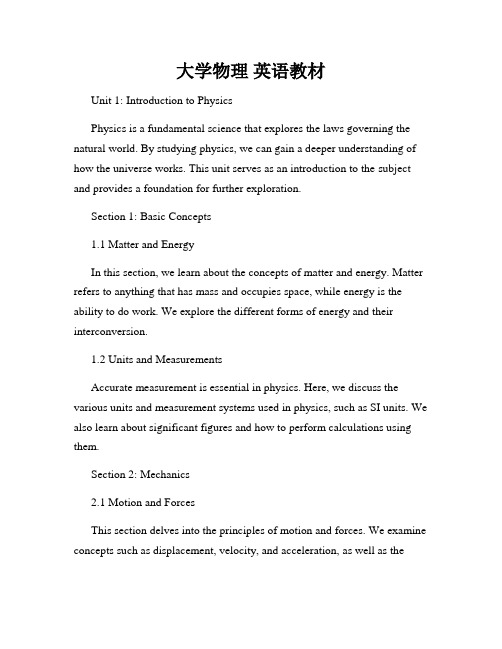
大学物理英语教材Unit 1: Introduction to PhysicsPhysics is a fundamental science that explores the laws governing the natural world. By studying physics, we can gain a deeper understanding of how the universe works. This unit serves as an introduction to the subject and provides a foundation for further exploration.Section 1: Basic Concepts1.1 Matter and EnergyIn this section, we learn about the concepts of matter and energy. Matter refers to anything that has mass and occupies space, while energy is the ability to do work. We explore the different forms of energy and their interconversion.1.2 Units and MeasurementsAccurate measurement is essential in physics. Here, we discuss the various units and measurement systems used in physics, such as SI units. We also learn about significant figures and how to perform calculations using them.Section 2: Mechanics2.1 Motion and ForcesThis section delves into the principles of motion and forces. We examine concepts such as displacement, velocity, and acceleration, as well as thevarious types and effects of forces. Newton's laws of motion are also introduced in this section.2.2 Energy and WorkUnderstanding the relationship between energy and work is crucial. We learn about different forms of energy, such as kinetic and potential energy, and how they are related to work. The principle of conservation of energy is also discussed.Section 3: Waves and Optics3.1 Wave PropertiesWaves are an integral part of physics. We explore the characteristics and properties of waves, including wavelength, frequency, and amplitude. This section covers different types of waves, such as sound waves and electromagnetic waves.3.2 OpticsOptics focuses on the behavior of light and its interaction with matter. Topics covered include reflection, refraction, and the formation of images by mirrors and lenses. We also learn about the basics of geometric optics.Unit 2: Electricity and MagnetismElectricity and magnetism are closely related phenomena that have a significant impact on our daily lives. This unit introduces the principles and applications of these concepts.Section 1: Electric Charge and Electric Field1.1 Electric ChargeHere, we learn about the fundamental property of matter known as electric charge. We explore the behavior of charged objects and the principles of electrostatics, including Coulomb's law.1.2 Electric FieldThe concept of an electric field is crucial for understanding how charges interact. We study the properties and behavior of electric fields, including how they are formed and their effects on charged particles.Section 2: Electric Circuits2.1 Current and ResistanceCurrent is the flow of electric charge, and resistance measures the opposition to this flow. We delve into the principles of current, resistance, and Ohm's law, which relates these quantities.2.2 Circuits and Circuit ElementsThis section focuses on electrical circuits and the various components that make them up. We learn about series and parallel circuits, as well as resistors, capacitors, and inductors.Section 3: Magnetism and Electromagnetism3.1 Magnetic FieldsMagnetic fields are responsible for the behavior of magnets and their interaction with other objects. We study the properties and behavior of magnetic fields, including their effects on moving charges.3.2 Electromagnetic InductionThe principle of electromagnetic induction is crucial for understanding the generation of electric currents. We explore Faraday's law and how changing magnetic fields can induce currents in conductors.Unit 3: Modern PhysicsModern physics revolutionized our understanding of the universe, particularly at the atomic and subatomic levels. This unit introduces the key concepts and discoveries of modern physics.Section 1: Quantum Mechanics1.1 Wave-Particle DualityThe wave-particle duality of matter and light is a cornerstone of quantum mechanics. We explore the behavior of particles and waves at the quantum level, including the famous double-slit experiment.1.2 Quantum States and Energy LevelsQuantum systems have discrete energy levels. Here, we learn about quantum states, wavefunctions, and the probabilistic nature of quantum mechanics. We also discuss the Schrödinger equation.Section 2: Particle Physics2.1 Subatomic ParticlesThis section focuses on the properties and classifications of subatomic particles, such as protons, neutrons, and electrons. We also introduce the concept of fundamental particles and their interactions.2.2 Nuclear ReactionsNuclear reactions involve changes in atomic nuclei and release tremendous amounts of energy. We study the principles behind nuclear reactions, including radioactive decay and nuclear fusion.ConclusionThe study of physics is essential for understanding the fundamental laws that govern our universe. This English textbook provides a comprehensive introduction to the subject, covering topics ranging from classical mechanics to modern physics. By studying this textbook and engaging with the content, students can develop a deep appreciation for the beauty and complexity of the natural world.。
物理专业英语讲解

3、能写作简单的专业语句,能正确无误地写 作论文的英文摘要。
4、阅读是侧重,基本上结合阅读实践来讲解
Dynamics is the study of forces and their effects on the motions of bodies. The cause of acceleration is a force exerted by some external agent or environment. The fundamental properties of force and the relationship between force and acceleration are given by Newton’s three laws of motion. The first of these laws describes the natural state of motion of a free body on which no external forces are acting, whereas the other two laws deal with the behavior of bodies under the influence of force.
2.语言必须符合规范,符合本民族语言习惯。
3.专业术语正确,数据无误,具有科学性。
准确
You cannot be too careful.
I couldn’t get home fast enough. 我恨不得马上回到家里。
No man can have too many friends. 朋友愈多愈好。
大学物理课程中英文简介
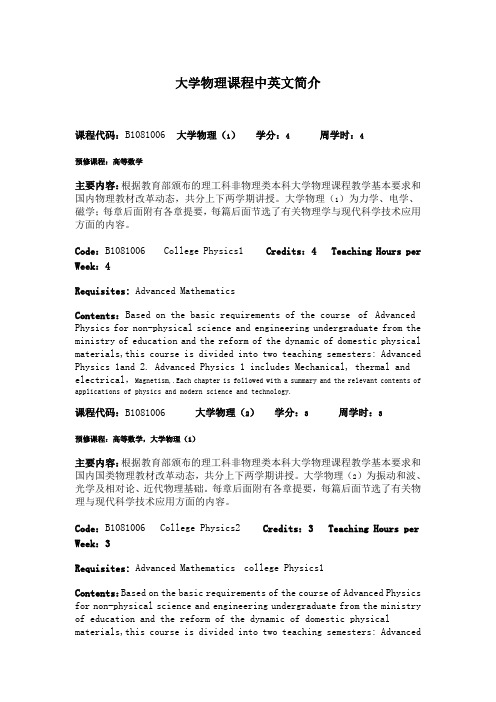
大学物理课程中英文简介课程代码:B1081006大学物理(1)学分:4 周学时:4预修课程:高等数学主要内容:根据教育部颁布的理工科非物理类本科大学物理课程教学基本要求和国内物理教材改革动态,共分上下两学期讲授。
大学物理(1)为力学、电学、磁学;每章后面附有各章提要,每篇后面节选了有关物理学与现代科学技术应用方面的内容。
Code:B1081006College Physics1Credits:4Teaching Hours per Week:4Requisites: Advanced MathematicsContents:Based on the basic requirements of the course of Advanced Physics for non-physical science and engineering undergraduate from the ministry of education and the reform of the dynamic of domestic physical materials,this course is divided into two teaching semesters: Advanced Physics 1and 2. Advanced Physics 1 includes Mechanical, thermal and electrical,Magnetism,.Each chapter is followed with a summary and the relevant contents of applications of physics and modern science and technology.课程代码:B1081006大学物理(2)学分:3 周学时:3预修课程:高等数学,大学物理(1)主要内容:根据教育部颁布的理工科非物理类本科大学物理课程教学基本要求和国内国类物理教材改革动态,共分上下两学期讲授。
《大学物理》课程教学大纲
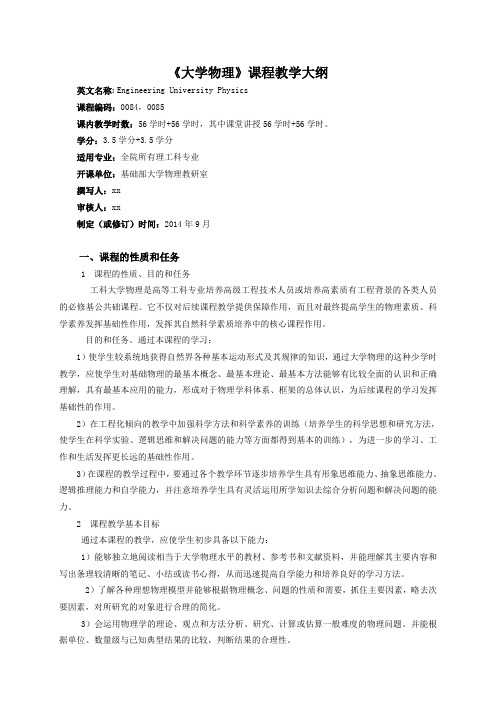
《大学物理》课程教学大纲英文名称: Engineering University Physics课程编码:0084,0085课内教学时数:56学时+56学时,其中课堂讲授56学时+56学时。
学分:3.5学分+3.5学分适用专业:全院所有理工科专业开课单位:基础部大学物理教研室撰写人:xx审核人:xx制定(或修订)时间:2014年9月一、课程的性质和任务1 课程的性质、目的和任务工科大学物理是高等工科专业培养高级工程技术人员或培养高素质有工程背景的各类人员的必修基公共础课程。
它不仅对后续课程教学提供保障作用,而且对最终提高学生的物理素质、科学素养发挥基础性作用,发挥其自然科学素质培养中的核心课程作用。
目的和任务。
通过本课程的学习:1)使学生较系统地获得自然界各种基本运动形式及其规律的知识,通过大学物理的这种少学时教学,应使学生对基础物理的最基本概念、最基本理论、最基本方法能够有比较全面的认识和正确理解,具有最基本应用的能力,形成对于物理学科体系、框架的总体认识,为后续课程的学习发挥基础性的作用。
2)在工程化倾向的教学中加强科学方法和科学素养的训练(培养学生的科学思想和研究方法,使学生在科学实验、逻辑思维和解决问题的能力等方面都得到基本的训练),为进一步的学习、工作和生活发挥更长远的基础性作用。
3)在课程的教学过程中,要通过各个教学环节逐步培养学生具有形象思维能力、抽象思维能力、逻辑推理能力和自学能力,并注意培养学生具有灵活运用所学知识去综合分析问题和解决问题的能力。
2 课程教学基本目标通过本课程的教学,应使学生初步具备以下能力:1)能够独立地阅读相当于大学物理水平的教材、参考书和文献资料,并能理解其主要内容和写出条理较清晰的笔记、小结或读书心得,从而迅速提高自学能力和培养良好的学习方法。
2)了解各种理想物理模型并能够根据物理概念、问题的性质和需要,抓住主要因素,略去次要因素,对所研究的对象进行合理的简化。
大学课程中英文对照
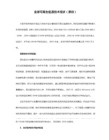
20 大学语文 College Chinese
21 大学英语 College English
22 高等数学 Advanced Mathematics
23 大学物理 College Physics
24 物理实验 Physical Experiment
45 马克思主义原理/马克思主义哲学 Marxism Philosophy
46 政治经济学 Plutonomy
47 邓小平理论 Theory of Deng Xiaoping
48 形势与政策 Situation & Policy
49 体育 Physical Education
50 基础体育 Basic Physical Education
电视原理--------------Telecision Operation
数字图象处理----------Digital Image Processing
专业英语--------------Specialty
rinent in Electox Circuitry
微机原理--------------Principle of Microcomputer
毕业设计--------------Graduation Thesis
自动控制理论----------Automatic Control Theory
模拟电子电路----------Analogical Electronics
数字电子电路----------Digital Electronics
电机电器与供电--------Motor Elements and Power Supply
大学物理讲义 英文1-Introduction
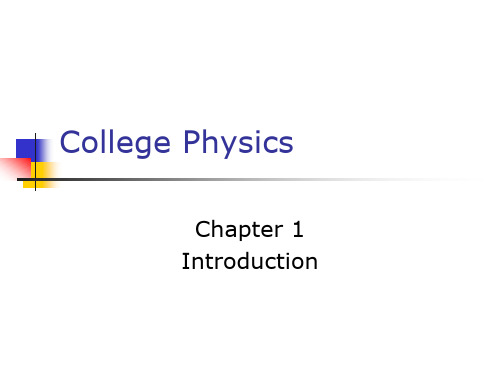
Examples: 1. x=x1+x2 2. x=t+m 3. v= x/t 4. E=1/2mv2
[x]=L, [x1]+[x2]=L, left side=right side [x]=L, [t]+[m]=T+M, left side ≠ right side [v]=L/T, [x]/[t]=L/T, left side=right side [E]=ML2/T2, 1/2[m][v2]= ML2/T2, left side =right side
Length
Units
SI – meter, m
One meter is defined the distance traveled by light in a vacuum during a time interval of 1/299792458 second With this definition, we establishes the speed of light to 299792458 m/s
We will use the rules for significant figures to approximate the uncertainty in results of calculations
Significant Figures
A significant figure is one that is reliably known All non-zero digits are significant Zeros used to position the decimal point are not significant.
大学物理课程介绍
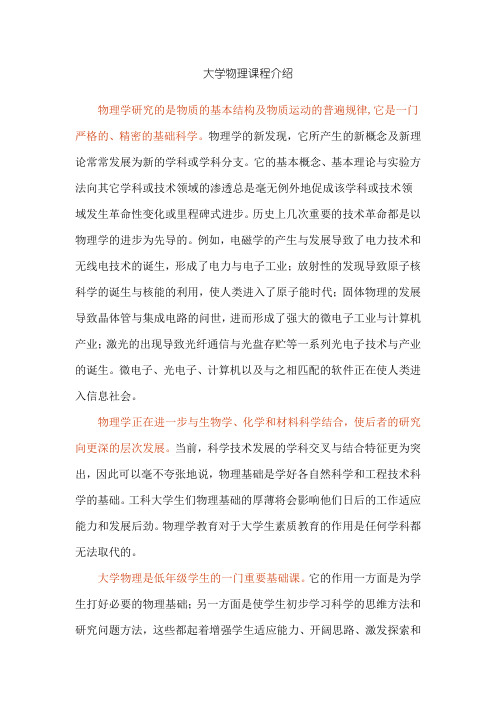
大学物理课程介绍物理学研究的是物质的基本结构及物质运动的普遍规律,它是一门严格的、精密的基础科学。
物理学的新发现,它所产生的新概念及新理论常常发展为新的学科或学科分支。
它的基本概念、基本理论与实验方法向其它学科或技术领域的渗透总是毫无例外地促成该学科或技术领域发生革命性变化或里程碑式进步。
历史上几次重要的技术革命都是以物理学的进步为先导的。
例如,电磁学的产生与发展导致了电力技术和无线电技术的诞生,形成了电力与电子工业;放射性的发现导致原子核科学的诞生与核能的利用,使人类进入了原子能时代;固体物理的发展导致晶体管与集成电路的问世,进而形成了强大的微电子工业与计算机产业;激光的出现导致光纤通信与光盘存贮等一系列光电子技术与产业的诞生。
微电子、光电子、计算机以及与之相匹配的软件正在使人类进入信息社会。
物理学正在进一步与生物学、化学和材料科学结合,使后者的研究向更深的层次发展。
当前,科学技术发展的学科交叉与结合特征更为突出,因此可以毫不夸张地说,物理基础是学好各自然科学和工程技术科学的基础。
工科大学生们物理基础的厚薄将会影响他们日后的工作适应能力和发展后劲。
物理学教育对于大学生素质教育的作用是任何学科都无法取代的。
大学物理是低年级学生的一门重要基础课。
它的作用一方面是为学生打好必要的物理基础;另一方面是使学生初步学习科学的思维方法和研究问题方法,这些都起着增强学生适应能力、开阔思路、激发探索和创新精神,提高人才科学素质的重要作用。
打好物理基础,不仅对学生在校学习起着十分重要的作用,而且对学生毕业后的工作和在工作中进一步学习新理论、新知识、新技术,不断更新知识都将产生深远的影响。
大学物理课程的内容包括有经典物理和近代物理。
经典物理部分主要包括:经典力学、热学、电磁学、光学等;近代物理部分主要包括:狭义相对论力学基础、量子力学基础、固体能带理论简介等。
经典物理在科学技术领域仍然是应用最广泛的基础理论,而且也是学习近代科学技术新理论、新知识的重要基础理论,在大学物理的学习中对经典物理内容仍应予以重视;大学物理中的近代物理知识是学生今后学习近代科学技术新理论,新知识所必须的近代物理基础理论知识。
物理学专业英语翻译

2.1 Introduction(引言)We begin our study of the physical universe by examining objects in motion. Thestudy of motion . whose measurement. more than 400 years ago gave birth to physics. iscalled kinematics.Much of our understanding of nature comes from observing the motion of objects. Inthis chapter we will develop a description for the motion of a single point as it movesthrough space. Although a point is a geometrical concept quite different from everydayobjects such as footballs and automobiles, we shall see that the actual mot10n of manyobjects is most easily described as the motion of a single point (the "center of mass"). plusthe rotation of the object about that point. Postponing a discussion of rotation. let usbegin he-re with a description of a single point as it moves through space. Space and timeKinematics is concerned with two basic questions. "Where?" and "When?". Thoughthe questions are simple. the answers are potentially quite complicated if we inquire aboutphenomena outside our ordinary daily experiences. For example. the physics of very highspeeds, or of events involving intergalactic distances or submicroscopic dimensions. isquite different from our common-sense ideas. We will discuss the… interesting subjects inlater chapters. For the present we shall adopt the space and time of Newton-thoseconcepts we gradually developed as a result of our everyday experiences.Space is assumed to be continuously uniform and isotropic. These two terms meanthat space has no 'graininess' and that whatever its properties may be, they areindependent of any particular direction or location. in the words of Isaac Newton.' Absolute space . in its own nature . without relation to anything external . remains alwayssimilar and unmovable. " Every object in the universe exists at a particular location inspace. and an object may change its location Ly moving through space as time goes on. Wespecify the Location of a particular point in space by its relation to a frame of reference.Time, according to Newton, is also absolute in the sense that it "flows on" at auniform rate . We cannot speed it up or slow it down in any way. in Newton's words," Absolute. true. and mathematical time . of itself . and from its own nature . flows equablywithout relation to anything external. and by another name is called duration. " Time isassumed to be continuous and ever advancing. as might be indicated by a clock.Space and time are wholly independent of each other. though it is recognized that allphysical objects must exist simultaneously in both space and time.Remarkably . many of these traditional ideas turn out to be naive and inconsistent withexperimental evidence. The world is just different from the picture we form from ourcommon-sense. intuitive ideas. Space and time, by themselves. arc concepts that arcdifficult (or perhaps impossible) to define in terms of anything simpler. However. we canmeasure space and time in unambiguous ways. We define certain operations by which weobtain numerical measurements of these quantities using rulers and clocks. based uponstandard units of space and time.For many years. our standard of time was based on astronomical observations of the earth'srotation. Because of the variations in the earth’s rotation . in 1967 the 13th General Conference onWeights and Measures. attended by 38 nations. adopted an atomic standard for time.Similarly. our former standard of length was the distance between two marks onplatinum-iridium bar. kept at Sevres. France. in 1960. the fundamental length standardwas redefined in terms of the wavelength of light emitted during a transition between two.The standard units of time and length may be described as follows:An interval of time. The fundamental unit is the second (s) . which by internationalagreement is defined as the duration of 9 192 631 770 periods of radiation corresponding tothe transition between the two lowest energy levels in the atomic isotope cesium 133.An interval of length. The fundamental unit is the meter (m). which is defined independently of the time interval Before 1983 . by international agreement the meter wasdefined as exactly 1 650 763. 73 wavelengths of the orange light emitted from the isotopekrypton 86. in November 1983. the length standard was defined as the distance that lighttravels in a vacuum in l1299 792 458 second.l angstrom(A) -. 10-l0 m l micron (u or um)10-6 m2.1简介(引言)我们开始研究宇宙的物理研究物体的运动。
大学物理(上)英文课程描述
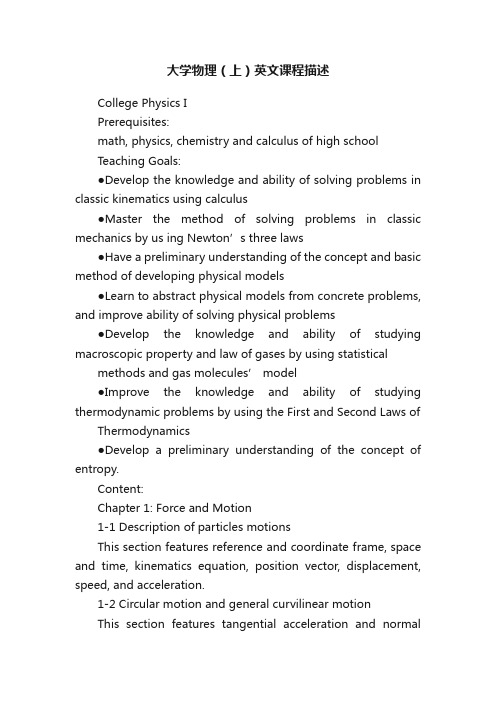
大学物理(上)英文课程描述College Physics IPrerequisites:math, physics, chemistry and calculus of high schoolTeaching Goals:●Develop the knowledge and ability of solving problems in classic kinematics using calculus●Master the method of solving problems in classic mechanics by us ing Newton’s three laws●Have a preliminary understanding of the concept and basic method of developing physical models●Learn to abstract physical models from conc rete problems, and improve ability of solving physical problems●Develop the knowledge and ability of studying macroscopic property and law of gases by using statistical methods and gas molecules’ model●Improve the knowledge and ability of studying thermodynamic problems by using the First and Second Laws of Thermodynamics●Develop a preliminary understanding of the concept of entropy.Content:Chapter 1: Force and Motion1-1 Description of particles motionsThis section features reference and coordinate frame, space and time, kinematics equation, position vector, displacement, speed, and acceleration.1-2 Circular motion and general curvilinear motionThis section features tangential acceleration and normalacceleration,angular variables of circle motion,vector of throwing motion.1-3 Relative motion, common forces and fundamental forces 1-4 Newton’s law of motion and examples of its applications1-5 Galilean principle of relativity, non-inertial system, inertial force,spatial-temporal view of classical mechanics Chapter 2: Conserved quantities and conservation law 2-1 Internal and external forces of particles system,theorem of centroid movement2-2 Theorem of momentum,law of conservation of momentum2-3Work and theorem of kinetic energy2-4 Conservative force, work of paired force, potential energy 2-5 Work-energy principal of particles system, law of conservation of mechanical energy2-6 Collision2-7 Law of conservation of angular momentum2-8 Symmetry and law of conservationChapter 3:motion of rigid body and fluid3-1 Model of rigid body and its motion3-2Moment of force, rotational inertia, law of fix-axis rotation3-3 Work-energy relation in fix-axis rotation3-4 Angular momentum theorem and conversation law of rigid body in fixed-axis3-5 Procession3-6 Perfect fluid model, steady flow, Bernouli Equation3-7 Chaos, inherent randomness of Newtonian mechanicsChapter 4:Foundation of the theory of relativity4-1 Basic principles of special theory of relativity, Lorentz transformation4-2 Speed conversion of relativity4-3 Spatial-Temporal view of special relativity4-4 Foundation of dynamics in special relativity4-5 Brief introduction to general relativityChapter 5:Kinetic theory of gases5-1 Description of thermal motion, of the ideal gas model and state equation5-2 Molecular thermal motion and statistical law5-3 Pressure and temperature formula of ideal gas5-4 Energy Equipartition Theorem , internal energy of ideal gas5-5 Maxwell Distributions of Speeds5-6 Maxwell- Boltzmann energy distribu tion law, particle’s d istribution in gravitational field according to altitude 5-7 Molecular collision and mean free path5-8Transport phenomena in gas5-9 A ctual gas, Van der Waals’s EquationChapter 6: Basics of thermodynamics6-1 Zeroth and the First Law of Thermodynamics6-2 Applications of the First law of Thermodynamics in quasi-static process of ideal gas6-3 Cyclic process, Carnot Cycle6-4 Second Law of Thermodynamics6-5 Reversible process and irreversible process, Carnot Theorem6-6 Entropy, Boltzmann Relation6-7 Statistically significance of the Second Law of Thermodynamics, Mathematical expression6-8Dissipative structure, information entropyCourse Requirements:Homework assignments and class participation (30%)Midterm examination(35%)Final examination(35%)Suggested TextbookGeneral Physics Author: Shouzhu Chen and Zhiyong Jiang; Publisher: Higher Education Press 2006Supplemental MaterialsMechanics Author: Kunmiao Liang; Publisher: Higher Education Press 2010Thermotics Author: Yunhao Qin; Publisher: Nanjing Uiversity Press 1990General Physics Author: Shouzhu Chen, Zhiyong Jiang; Publisher: Higher Education Press 2006Physics Auhor: Kezhe Liu, Zhiyong Jiang; Publisher: Higher Education Press 2006College Fundamental Physics Author: Sanhui Zhang; Publisher:Tsinghua University Press 2003。
大学物理(双语)
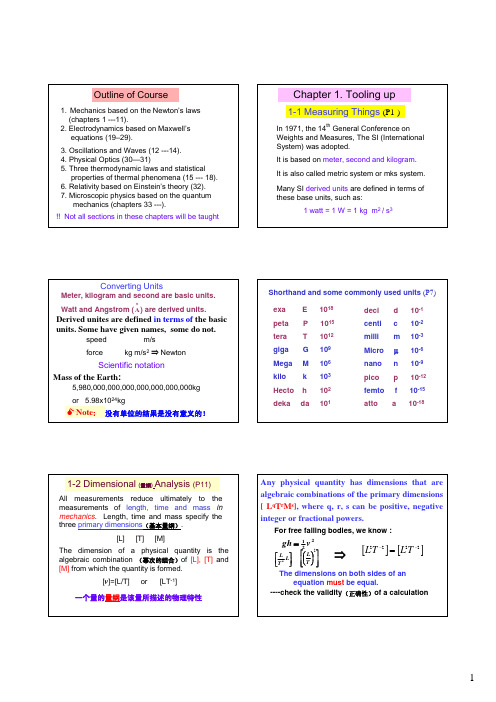
v = v x2 + v y2
v and tanθ = v y x
r r r Ar B = C × r
r C
r B
α
Both pairs of values contain the same information.
Direction ( figure )
r A
2
�
?
Coordinate system can be chosen freely.
Components of vectors (50)
A component of a vector is the projection of the vector on an axis. This component may be in 2 or 3 dimensional (3D) coordinate system.
gh = 1 v 2 2
L T 2 L
L 2 T
[L T ] = [L T ]
2 2 2 2
一个量的量纲是该量所描述的物理特性
The dimensions on both sides of an equation must be equal. ----check the validity(正确性)of a calculation
Watt and Angstrom ( A ) are derived units.
Derived unites are defined in terms of the basic units. Some have given names, some do not.
speed force m/s kgm/s2 Newton
Scientific notation Mass of the Earth:
PHY01大学物理教学大纲-中英文版
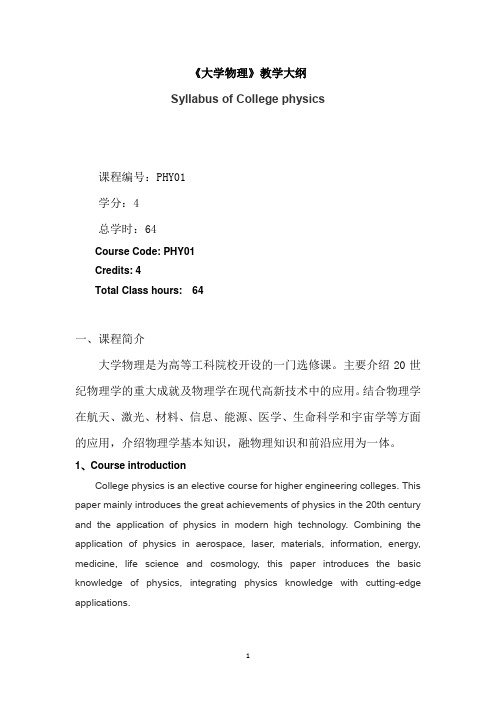
《大学物理》教学大纲Syllabus of College physics课程编号:PHY01学分:4总学时:64Course Code: PHY01Credits: 4Total Class hours: 64一、课程简介大学物理是为高等工科院校开设的一门选修课。
主要介绍20世纪物理学的重大成就及物理学在现代高新技术中的应用。
结合物理学在航天、激光、材料、信息、能源、医学、生命科学和宇宙学等方面的应用,介绍物理学基本知识,融物理知识和前沿应用为一体。
1、Course introductionCollege physics is an elective course for higher engineering colleges. This paper mainly introduces the great achievements of physics in the 20th century and the application of physics in modern high technology. Combining the application of physics in aerospace, laser, materials, information, energy, medicine, life science and cosmology, this paper introduces the basic knowledge of physics, integrating physics knowledge with cutting-edge applications.二、教学目标通过本课程的学习,使学生获得物理学基本知识,拓展学生的知识面,培养学生的科学思维方法和研究方法,提高学生的自然科学素质。
2、Instructional objectivesThrough the study of this course, students can acquire the basic knowledge of physics, expand their knowledge, cultivate their scientific thinking methods and research methods, and improve their natural science quality.三、教学大纲3、Teaching programme第一章导论1、教学内容(1)了解经典物理学产生的条件和建立过程;(2)了解19世纪物理学的成就和危机;(3)了解20世纪物理学的发展及其特点;(4)了解物理学的社会教育和思想文化功能。
18大学物理 Ilya Prigogine--中英文讲稿
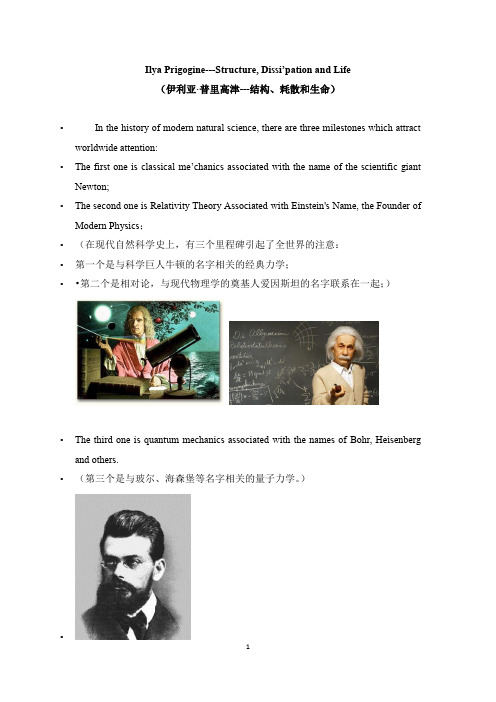
Ilya Prigogine---Structure, Dissi’pation and Life(伊利亚·普里高津---结构、耗散和生命)•In the history of modern natural science, there are three milestones which attract worldwide attention:•The first one is classical me’chanics associated with the name of the scientific giant Newton;•The second one is Relativity Theory Associated with Einstein's Name, the Founder of Modern Physics;•(在现代自然科学史上,有三个里程碑引起了全世界的注意:•第一个是与科学巨人牛顿的名字相关的经典力学;••第二个是相对论,与现代物理学的奠基人爱因斯坦的名字联系在一起;)•The third one is quantum mechanics associated with the names of Bohr, Heisenberg and others.•(第三个是与玻尔、海森堡等名字相关的量子力学。
)•••For decades, scientists all over the world have been looking up to the peak of science while looking forward to the rise of another giant monument, Ilya Prigogine----A physicist who views the world from the perspective of evolution. •(•几十年来,全世界的科学家都在仰望科学的巅峰,同时期待着另一座巨大的纪念碑——从进化的角度看待世界的物理学家伊利亚·普里高津的崛起。
大学物理英汉词汇对照资料讲解

大学物理英汉词汇对照1、mechanical motion 机械运动2、theory of relativity 相对论3、particl 质点4、frame of reference 参照系5、position vector 位置矢量6、equation of motion 运动方程7、orbit 轨道8、distance 路程9、displacement 位移10、velocity 速度11、acceleration 加速度12、tangential acceleration 切向加速度13、normal acceleration 切向加速度14、Newton's law of motion 牛顿运动定律15、inertia 惯性16、force 力17、moment of force 力矩18、Galileo transformation 伽利略变换19、system 系统20、work 功21、kinetic energy 动能22、potential energy 势能23、mechanical energy 机械能24、momentum 动量25、angular momentum 角动量26、Lorentz transformation 洛仑兹变换27、mol 摩尔28、atmospheric pressure 大气压29、standard condition 标准状况30、ideal gas 理想气体31、gas constant 气体常数32、Avogadro’s number阿伏伽德罗数33、distribution function of speed 速率分布函数34、most probable speed 最概然速率35、average speed 平均速率36、root-mean-square speed 方均根速率37、degree of freedom 自由度38、diatomic molecule 双原子分子39、polyatomic molecule 多原子分子40、theorem of equipartition of energy 能量均分定理41、collision frequency 碰撞频率42、free path 自由程43、temperature 温度44、electromagnetism 电磁学45、electric field 电场46、magnetic field 磁场47、electromagnetic field 电磁场48、electromagnetic wave 电磁波49、Maxwell’s equations麦克斯韦方程组50、electromagnetic energy 电磁能量51、energy of electric field 电场能量52、energy of magnetic field 磁场能量53、Poynting’s vector坡印廷矢量54、energy flow density 能流密度55、Lorentz force 洛伦兹力56、electron 电子57、electron theory 电荷58、point charge 点电荷59、charge density 电荷密度60、conservation law of charge 电荷守恒定律61、bound charge 束缚电荷62、free charge 自由电荷63、conductor 导体64、insulator 绝缘体65、dielectric 电介质66、C oulomb’s law库仑定律67、electrostatic field 静电场68、electric field strength 电场强度69、electric flux 电通量70、Gauss’s law高斯定理71、electric potential 电势72、electric potential difference 电势差73、equipotential surface 等势面74、electrostatic induction 静电感应75、induced charge 感生电荷76、electrostatic shielding 静电屏蔽77、electrostatic equilibrium 静电平衡78、capacitance 电容79、electric source 电源80、non-electrostatic force 非静电力81、electromotive force 电动势82、magnetostatic field 静磁场83、magnetic induction 磁感应强度83、magnetic field strength 磁场强度85、uniform magnetic field 均匀磁场86、magnetic induction flux 磁感应通量87、Ampere’s force安培力88、Hall effect 霍耳效应88、paramagnetic substance 顺磁质89、diamagnetic substance 抗磁质90、superconductivity 超导性91、ferromagnetic substance 铁磁质92、electromagnetic induction 电磁感应93、Faraday’s electromagnetic induction law 法拉第电磁感应定律94、induced electromotive force 感生电动势95、motional electromotive force 动生电动势96、(1)self induction (2)self inductance 自感97、(1)mutual induction (2)mutual inductance 互感98、eddy current 涡电流99、displacement current 位移电流100、electromagnetic oscillation 电磁振荡101、electromagnetic spectrum 电磁波谱102、electromagnetic theory of light 光的电磁理论103、Hertz’s experiment赫兹实验104、coulomb 库仑105、volt 伏特106、ohm 欧姆107、reciprocal ohm 姆欧108、siemens 西门子109、ampere 安培110、farad 法拉111、henry 亨利112、weber 韦伯113、vibration(vibration motion oscillation)振动114、harmonic oscillation 谐振动115、damped oscillation 阻尼振动116、forced oscillation 受迫振动117、linear oscillation 线性振动118、mechanical oscillation 机械振动119、thermal oscillation 热振动120、light oscillation 光振动121、period 周期122、frequency 频率123、amplitude 振幅124、phase 相位125、synthesis 合成126、rotating vector 旋转矢量127、wave 波动128、superposition 迭加129、mechanical wave 机械波130、electromagnetic ware 电磁波131、longitudinal waves 纵波132、transversal waves 横波133、ware surface 波面134、ray 波线135、wave front 波前136、wave speed 波速137、plane wave平面波138、spherical waves 球面波139、harmonic waves 简谐波140、wave function 波函数141、wavelength 波长142、wave number 波数143、interference 干涉144、coherent wave 相干波145、constructive interference 相长干涉146、destructive interference 相消干涉147、geometrical optics 几何光学148、modern optics 现代光学149、physical optics 物理光学150、wave optics 波动光学151、quantum optics 量子光学152、nonlinear optics 非线性光学153、applied optics 应用光学154、information optics 信息光学155、Fourier optics 傅里叶光学156、index of refraction 折射率157、photo vector 光矢量158、speed of light 光速159、Young’s two-slit interference 扬氏双缝干涉160、equal inclination interference 等倾干涉161、equal thickness interference 等厚干涉162、film interference 薄膜干涉163、diffraction 衍射164、Fresnel diffraction 菲涅尔衍射165、Fraunhofer diffraction 夫琅和费衍射166、Huygens-Fresnel principle 惠更斯-菲涅尔原理167、Single slit diffraction 单缝衍射168、Double slit diffraction 双缝衍射169、Circular hole diffraction 圆孔衍射170、X-ray diffraction X射线171、Electron diffraction 电子衍射172、Rayleigh criterion 瑞利判据173、grating 光栅174、grating constant 光栅常数175、grating spectrum 光栅光谱176、natural light(natural daylight)自然光177、polarized light 偏振光178、linearly polarized light 线偏振光151、partially polarized light 部分偏振光179、Malus law 马吕斯定律180、birefringence(double refraction)双折射181、ordinary light 寻常光182、extraordinary light 非寻常光184、thermal radiation 热辐射(heat radiation)(calorific radiation)184、black-body radiation 黑体辐射185、Planck’s qua ntum theory 普朗克量子论186、photo-electric effect 光电效应187、light quantum 光(量)子188、Compton effect 康普顿效应189、Compton wave lenghth 康普顿波长190、atomic structure 原子结构191、Bohr’s quantum theory 玻尔量子论192、Bohr radius 玻尔半径193、matter wave 物质波194、microscopic world 微观世界195、macroscopic world 宏观世界196、wave-particle duality 波粒二象性197、quantum physics 量子物理学198、length 长度199、mass 质量200、time 时间201、electric current 电流202、thermodynamic temperature 热力学温度203、amount of substance 物质的量204、luminous intensity 发光强度205、plane angle 平面角206、solid angle 立体角Prefixes Used With SI Units国际单位制使用的词头exa—艾E(1018)peta—拍P(1015)tera—太T(1012)giga—吉G(109)mega—兆M(106)kilo—千K(103)hecto—白h(102)deca—十da(10)deci—分d(10-1)centi—厘c(10-2)milli—毫m(10-3)micro—微μ(10-6)nano—纳n(10-9)pico—皮p(10-12)femto—飞f(10-15)affo—阿a(10-18)。
《大学物理B》教学大纲
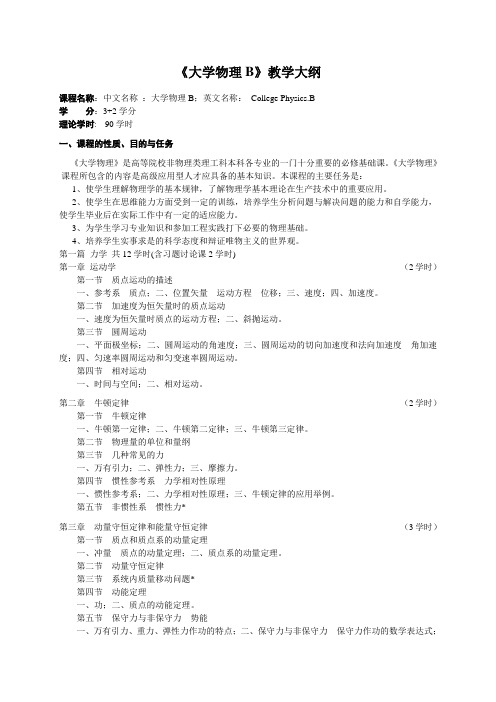
《大学物理B》教学大纲课程名称:中文名称:大学物理B;英文名称:College Physics.B学分:3+2学分理论学时: 90学时一、课程的性质、目的与任务《大学物理》是高等院校非物理类理工科本科各专业的一门十分重要的必修基础课。
《大学物理》课程所包含的内容是高级应用型人才应具备的基本知识。
本课程的主要任务是:1、使学生理解物理学的基本规律,了解物理学基本理论在生产技术中的重要应用。
2、使学生在思维能力方面受到一定的训练,培养学生分析问题与解决问题的能力和自学能力,使学生毕业后在实际工作中有一定的适应能力。
3、为学生学习专业知识和参加工程实践打下必要的物理基础。
4、培养学生实事求是的科学态度和辩证唯物主义的世界观。
第一篇力学共12学时(含习题讨论课2学时)第一章运动学(2学时)第一节质点运动的描述一、参考系质点;二、位置矢量运动方程位移;三、速度;四、加速度。
第二节加速度为恒矢量时的质点运动一、速度为恒矢量时质点的运动方程;二、斜抛运动。
第三节圆周运动一、平面极坐标;二、圆周运动的角速度;三、圆周运动的切向加速度和法向加速度角加速度;四、匀速率圆周运动和匀变速率圆周运动。
第四节相对运动一、时间与空间;二、相对运动。
第二章牛顿定律(2学时)第一节牛顿定律一、牛顿第一定律;二、牛顿第二定律;三、牛顿第三定律。
第二节物理量的单位和量纲第三节几种常见的力一、万有引力;二、弹性力;三、摩擦力。
第四节惯性参考系力学相对性原理一、惯性参考系;二、力学相对性原理;三、牛顿定律的应用举例。
第五节非惯性系惯性力*第三章动量守恒定律和能量守恒定律(3学时)第一节质点和质点系的动量定理一、冲量质点的动量定理;二、质点系的动量定理。
第二节动量守恒定律第三节系统内质量移动问题*第四节动能定理一、功;二、质点的动能定理。
第五节保守力与非保守力势能一、万有引力、重力、弹性力作功的特点;二、保守力与非保守力保守力作功的数学表达式;三、势能;四、势能曲线。
《大学物理B》课程简介

《大学物理B》课程简介
一、课程基本信息
课程代码:0702111003
课程名称:大学物理B
英文名称:College Physics B
学分:4 总学时:64
讲课学时:56 实验学时:8 上机学时:课外学时:
适用对象:四年制本科非理工科各专业
先修课程:高等数学
开课单位:数理部
二、课程内容与教学目标
本课程是文科专业学生的一门必修的基础课。
课程主要内容有人类在宇宙中的位置、力学概论、热学与能源工程、静电场、狭义相对论、量子物理、新技术简介。
它的主要任务是使学生了解经典物理学和现代物理学的发展史,理解物理学发展与社会生产和科学发展的辩证关系。
了解物理模型并能够根据物理概念、问题的性质和需要,抓住主要因素,略去次要因素,对所研究的对象进行合理的简化。
会运用物理学的理论、观点和方法来解决一些简单问题。
使学生在学习物理学知识的同时,逐步建立正确的思想方法和研究方法,充分发挥本课程在培养学生辩证唯物主义世界观方面的作用,进行科学素质教育。
三、对教学方式、实践环节、学生自主学习的基本要求
本课程采用板书与多媒体课件结合的方式进行课堂教学,学生应在课下对《大学物理》进行复习或预习并独立完成课后作业。
四、考核方式与学习成绩评定(请注明平时成绩、考试成绩、实验成绩等各部分占比)
本课程为考试课程,期末考试采用闭卷笔试。
学生的课程总评成绩由平时成绩(占30%)和期末考试成绩两部分构成。
平时成绩由出勤、作业、课堂测验、学习主动性等构成。
《大学物理》课程中英文简介

《大学物理》课程中英文简介College Physics课程代码:080013B Course Code:080013B课程名称:大学物理Course Name:College Physics学时:48 Periods:48学分:3 Credits:3考核方式:考查Assessment:Inspection先修课程:高等数学Preparatory Courses:Advanced Mathematics物理学是研究物质的基本结构、基本运动形式、相互作用的自然科学。
它的基本理论和研究方法渗透在自然科学的各个领域,是其他自然科学的基础。
以物理学基础为内容的大学物理课,是应用数学专业学生一门重要的通识性必修基础课。
本课程所教授的基本概念、基本理论和基本方法是学生科学素养的重要组成部分,在人才的科学素质培养中具有重要的地位,具有其他课程不能替代的重要作用。
通过本课程的教学,使学生能够掌握力学、热学、电磁学、波动与光学、近代物理学等基本理论知识,为学生毕业后所从事专业技术、管理及科学研究工作打下一定的基础。
Physics is a discipline of natural science which studies the basic structure, the basic movement form and the interaction of matters. Its elementary theories and research methods are the foundation of other natural sciences, which are widely used in all the domains of natural science.College Physics, which takes the foundation of basic physics as its main contents, is one of the compulsory basic courses for the students of mathematics and applied mathematics. The basic concepts, theories and essential methods of the course are an importa nt part of students’ scientific accomplishment and play an important role in improving talented people's scientific quality, which cannot be substituted by other courses.This course enables students to grasp the elementary knowledge of mechanics, thermodynamics, electromagnetism, wave and optics and modern physics. It provides a basis for the work they will do after graduation in the fields of technology, management and scientific research.《普通物理学及实验I》课程中英文简介General Physics and Experiments I课程代码:080024A/080023A Course Code:080024A/080023A课程名称:普通物理学及实验I Course Name:General Physics and Experiment I学时:64/48 Periods:64/48学分:4/3 Credits:4/3考核方式:考试Assessment:Examination先修课程:高等数学Preparatory Courses:Advanced Mathematics物理学是研究物质的基本结构、基本运动形式、相互作用的自然科学。
大学中常见课程和系别中英文对照

Practical English:大学常见课程中英文对照大学英语English高等数学Advanced Mathematics体育Physical Education军事理论Military Theory机械制图Mechanical Graphing算法语言Algorithmic Language大学物理College Physics物理实验Experiment of College Physics线性代数Linear Algebra法律基础Fundamentals of Law普通物理General Physics普通物理实验Lab of General Physics复变函数与积分变换Functions of Complex Variables & Integral Transformations电路理论Theory of Circuitry电路测试技术Circuit Measurement Technology概率论与随机过程Probability Theory & Stochastic Process信号与线性系统Signal & Linear System电子线路Circuitry脉冲与数字电路Pulse & Numerical Circuitry金工实习Metalworking Practice电工实习Electrical Engineering Practice电子线路实验Experiment in Electronic Circuitry微机原理Principle of Microcomputer电磁场与电磁波Electromagnetic Fields & Magnetic Waves 电机电器与供电Motor Elements and Power Supply计算方法Computational Method软件技术基础Basis of Software Technique微波技术Microwave Technique通讯原理Principle of Communication数字信号处理Digital Signal Processing微机实验Experiment of Microcomputer计算机接口技术Computer Interface Technologyc 语言 C languageCET-6College English Test (Band 6)工业企业管理Industrial Enterprise Management移动通讯Moving Communication光纤通讯系统Fiber Optical Communication System可靠性技术导论Introduction to Reliability Technology卫星通信Satellite Communications电视原理Television Operation数字图象处理Digital Image Processing专业英语Specialty English情报检索Information Searches毕业设计Graduation Thesis自动控制理论Automatic Control Theory模拟电子电路Analogical Electronics数字电子电路Digital Electronics资本主义经济Economy of Capitalism马克思主义原理Principle of Marxism机械原理Principle of Mechanic机械设计Mechanic Design最优控制Optimum Control微机控制技术Microcomputer Control Technology 过程控制Procedure Control自动控制系统Automatic Control System半导体变流技术Semiconductor converting Technique 运筹学Operational Research自动检测技术Auto-Measurement Technique传感器原理Principle of Sensing Device单片机原理Principle of Single-Chip computerHxenEnglishPractical English:大学系别名称中英文对照会计系 Dept. of Accounting农业系Dept.of Agriculture农业经济系 Dept.of Agricultural Economics农业化学系Dept.of Agricultural Chemistry农业工程系 Dept.of Agricultural Engineering畜牧系Dept.of Animal Husbandry人类学系 Dept.of Anthropology应用数学系Dept.of Applied Mathematics建筑系Dept. of Architecture考古学系Dept.of Archaeology天文系Dept.of Astronomy原子能系Dept.of Atomic Energy解剖系Dept. of Anatomy金融系 Dept.of Banking工商管理系Dept.of Business Administration生物学系Dept.of Biology生物化学系Dept.of Biochemistry植物学系Dept.of Botany细菌学系 Dept.of Bacteriology中文系Dept.of Chinese化学系Dept.of Chemistry化学工程系Dept.of Chemical Engineering控制工程系 Dept. of Control Engineering电信工程系Dept. of Communication Engineering 计算机科学系Dept.of Computer Science电脑资讯系 Dept.of Computer Information土木工程系 Dept.of Civil Engineering舞蹈系 Dept. of Dance牙科学系Dept.of Dentistry营养学系Dept.of Dietetics外交学系Dept.of Diplomacy经济系Dept.of Economics教育系Dept.of Education工程系 Dept.of Engineering环境工程系 Dept.of Environmental Engineering 英语系Dept. of English昆虫系 Dept.of Entomology电子物理系Dept.of Electrophysics电子工程系 Dept.of Electronic Engineering电机工程系 Dept.of Electrical Engineering眼耳鼻喉系Dept. of Eye, Ear, Nose and Throat渔业学系Dept.of Fishery水产学系 Dept.of Fishery Technology食品科学系 Dept.of Food Science外语系Dept. of Foreign Languages森林系Dept.of Forestry遗传系 Dept.of Genetics地理系 Dept.of Geography地质系Dept. of Geology地球物理系Dept.of Geophysics历史系 Dept.of History园艺系Dept.of Horticulture国际关系学系Dept.of International Relations 国际贸易系Dept. of International Trade工业设计系Dept. of Industrial Design工业管理系 Dept.of Industrial Management 新闻学系 Dept. of Journalism法律系Dept.of Law图书管理系 Dept.of Library Management文学系Dept.of Literature机械工程系Dept.of Mechanical Engineering 冶金系Dept.of Metallurgy管理科学系Dept.of Management Science大众传播系 Dept.of Mass Communication医学系 Dept.of Medical Science海洋运输学系 Dept.of Marine Transportation 航海技术系 Dept.of Maritime Technology 数学系Dept.of Mathematics气象系 Dept.of Meteorology矿业系 Dept.of Mining核子工程系Dept.of Nuclear Enginerring护理系Dept.of Nursing航海学系Dept.of Navigation海洋科学系 Dept.of Nautical Science造船学系Dept.of Naval Architecture 东方语言系Dept.of Oriental languages 海洋学系Dept.of Oceanography海洋气象学系 Dept. of Ocean Meteorology 石油系Dept.of Oil药学系Dept.of Pharmacology病理学系Dept.of Pathology政治系 Dept.of Political Science物理系Dept.of Physics体育系 Dept.of Physical Culture生理学系Dept.of Physiology植物病虫学系Dept.of Plant Pathology 植物生理系Dept.of Plant Physiology 哲学系Dept. of Philosophy电力物理系 Dept.of Power Physics印刷系Dept.of Printing公共卫生学系 Dept.of Public Health卫生工程学系Dept.of Sanitary Engineering土壤系Dept. of Soil纺织系Dept.of Spinning社会学系Dept.of Sociology测量系Dept.of Survey纺织工程系 Dept.of Textile Engineering戏剧系Dept.of Theatricals运输管理系Dept.of Transportation Management兽医学系 Dept. of Veterinary Medicine水利系Dept. of Water Conservancy水土保持系Dept. of Water & Soil Maintenance Engineering 西方语言系 Dept. of Western Languages动物学系Dept.of ZoologyHjiangEnglish。
大学物理课程标准
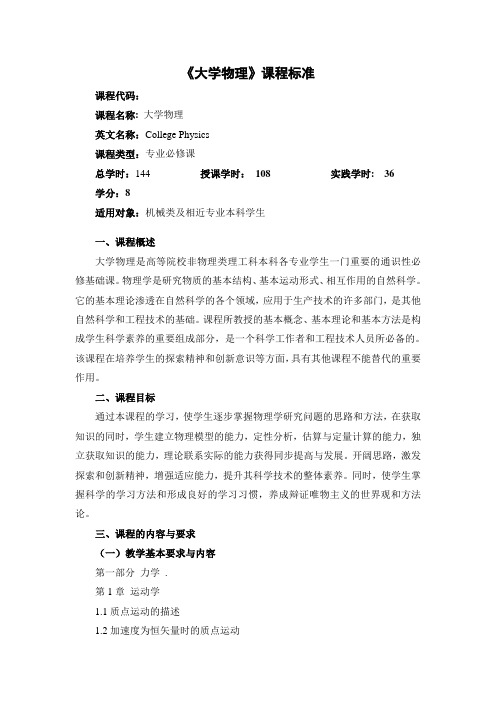
《大学物理》课程标准课程代码:课程名称:大学物理英文名称:College Physics课程类型:专业必修课总学时:144 授课学时:108 实践学时: 36学分:8适用对象:机械类及相近专业本科学生一、课程概述大学物理是高等院校非物理类理工科本科各专业学生一门重要的通识性必修基础课。
物理学是研究物质的基本结构、基本运动形式、相互作用的自然科学。
它的基本理论渗透在自然科学的各个领域,应用于生产技术的许多部门,是其他自然科学和工程技术的基础。
课程所教授的基本概念、基本理论和基本方法是构成学生科学素养的重要组成部分,是一个科学工作者和工程技术人员所必备的。
该课程在培养学生的探索精神和创新意识等方面,具有其他课程不能替代的重要作用。
二、课程目标通过本课程的学习,使学生逐步掌握物理学研究问题的思路和方法,在获取知识的同时,学生建立物理模型的能力,定性分析,估算与定量计算的能力,独立获取知识的能力,理论联系实际的能力获得同步提高与发展。
开阔思路,激发探索和创新精神,增强适应能力,提升其科学技术的整体素养。
同时,使学生掌握科学的学习方法和形成良好的学习习惯,养成辩证唯物主义的世界观和方法论。
三、课程的内容与要求(一)教学基本要求与内容第一部分力学.第1章运动学1.1质点运动的描述1.2加速度为恒矢量时的质点运动1.3圆周运动1.4相对运动基本要求:1.深入地理解质点、位移、速度和加速度等重要概念,深入理解质点的运动。
2.分析加速度为恒矢量时的质点运动方程。
3.明确圆周运动中角位移、角速度、切向加速度、法向加速度的关系。
重点与难点:1.加速度为恒矢量时质点运动方程的描写。
2.质点圆周运动的分析。
第2章牛顿定律2.1牛顿定律2.2物理量的单位和量纲2.3几种常见的力2.4惯性参考系力学相对性原理基本要求:1.清晰的理解牛顿第一定律、牛顿第二定律和牛顿第三定律。
2.熟练掌握几种常见力。
3.掌握物理量的单位和量纲。
- 1、下载文档前请自行甄别文档内容的完整性,平台不提供额外的编辑、内容补充、找答案等附加服务。
- 2、"仅部分预览"的文档,不可在线预览部分如存在完整性等问题,可反馈申请退款(可完整预览的文档不适用该条件!)。
- 3、如文档侵犯您的权益,请联系客服反馈,我们会尽快为您处理(人工客服工作时间:9:00-18:30)。
大学物理课程中英文简介
课程代码:B1081006大学物理(1)学分:4 周学时:4
预修课程:高等数学
主要内容:根据教育部颁布的理工科非物理类本科大学物理课程教学基本要求和国内物理教材改革动态,共分上下两学期讲授。
大学物理(1)为力学、电学、磁学;每章后面附有各章提要,每篇后面节选了有关物理学与现代科学技术应用方面的内容。
Code:B1081006College Physics1Credits:4Teaching Hours per Week:4
Requisites: Advanced Mathematics
Contents:Based on the basic requirements of the course of Advanced Physics for non-physical science and engineering undergraduate from the ministry of education and the reform of the dynamic of domestic physical materials,this course is divided into two teaching semesters: Advanced Physics 1and 2. Advanced Physics 1 includes Mechanical, thermal and electrical,Magnetism,.Each chapter is followed with a summary and the relevant contents of applications of physics and modern science and technology.
课程代码:B1081006大学物理(2)学分:3 周学时:3
预修课程:高等数学,大学物理(1)
主要内容:根据教育部颁布的理工科非物理类本科大学物理课程教学基本要求和国内国类物理教材改革动态,共分上下两学期讲授。
大学物理(2)为振动和波、光学及相对论、近代物理基础。
每章后面附有各章提要,每篇后面节选了有关物理与现代科学技术应用方面的内容。
Code:B1081006College Physics2Credits:3Teaching Hours per Week:3
Requisites: Advanced Mathematics college Physics1
Contents:Based on the basic requirements of the course of Advanced Physics for non-physical science and engineering undergraduate from the ministry of education and the reform of the dynamic of domestic physical materials,this course is divided into two teaching semesters: Advanced
Physics 1 and 2. Advanced Physics 2 includes vibration and wave, Optics and Basic modern physics. Each chapter is followed with a summary and the relevant contents of applications of physics and modern science and technology.。
